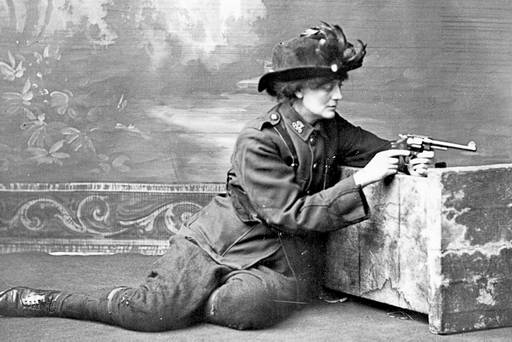1916 Surrenders: Captain H. E. de Courcy-Wheeler’s Eye-Witness Account
by Alex Findlater (Edited by A & A Farmar)
Produced by Dún Laoghaire-Rathdown County Council, €11.99)
This short engaging book, compiled from family papers by Alex Findlater, largely comprises a facsimile of the memoir of his grandfather Captain H. C. (Harry) de Courcy-Wheeler (“DeCW”) relating to some the events of Easter 1916.
DeCW was a staff captain involved in the administration of the Curragh Camp during the First World War. His home was at Robertstown, Co. Kildare, but he moved to married quarters at the Curragh Camp until he was demobilised in 1919.
Surrender
Called to Dublin by Brigadier General Lowe, DeCW’s initial work at Parkgate Street was administrative, but when word of the surrender came through he accompanied Lowe to take the surrender of Pearse.
DeCW considered he was chosen partly because he was a barrister and a justice of the peace. He is believed to be the photographer who took the iconic photograph of Pearse’s surrender reproduced in the book.
A surrender order was produced in multiple copies and signed by Pearse. DeCW then crisscrossed the city as surrender orders were added by James Connolly and by Thomas MacDonagh. Then, in conjunction with Nurse O’Farrell, the surrender of the various commands was arranged.
Nurse O’Farrell emerges from DeCW’s narrative as a lady of considerable courage who fulfilled what must have been a very bitter task with dignity. One of the duplicates of the surrender orders (the original, produced at the trial of Connolly, may now be in the Royal Archive at Windsor) is reproduced, signed by Pearse, by Connolly for the men only under his own command in the Moore Street District, and for the men in the St Stephen’s Green Command.
DeCW took the surrender at the College of Surgeons on Stephen’s Green where the Countess Markievicz was second in command. When doing so, the Countess, a first cousin of DeCW’s wife and after whom they had named their recently born daughter, kissed one of the two pistols she carried before handing them over.
Witness
DeCW was a witness at a number of the trials. Present in advance of the trial of Patrick Pearse at Richmond barracks his evidence was deemed unnecessary by the representative of the Judge Advocate General and the Prosecutor, but DeCW did give evidence at the trials of the Countess, Mallin, Connolly and McDermott.
Given the family connection, he understandably but significantly omits the ambiguous phrase of the Countess’ closing statement “It doesn’t matter what happens to me” – the interpretation of which depends entirely upon her body language: however nothing concerning the Countess is straight forward, for the court recorded that DeCW had withdrawn before the Countess made her statement.
DeCW was demobilised at the end of the war and went back to Robertstown. His wife died in 1928, following a hockey injury, and the property was sold during the depressed years of the 1930s. In 1949 he presented to President Sean T. O’Kelly the arms and equipment surrendered by Pearse and Markievicz in 1916. DeCW had held these throughout the War of Independence and the Civil War, presumably unconscious of the risk they posed to his own safety.
This book which is illustrated with contemporaneous 1916 photographs and photographs of the presentation to the State in 1949 also contains a statement by Dorothea Findlater, DeCW’s daughter who, aged six at the time of the Rising, is now one of the few who have memories of that Easter.
Alex Findlater and the producers, Dún Laoghaire-Rathdown County Council, have done us a great service bringing this material to a wider public as a ready source for closer study of the events.


 Countess Markievicz
Countess Markievicz 